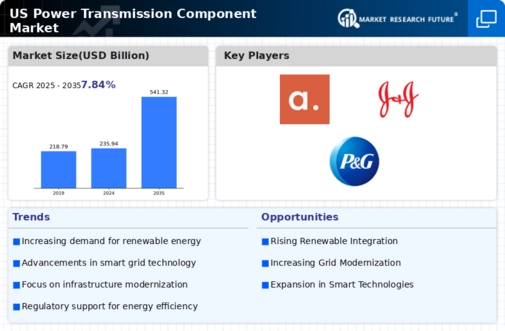Increased Energy Demand
The rising demand for energy in the United States is a fundamental driver for the power transmission-component market. Factors such as population growth, urbanization, and economic development contribute to this increasing demand. The U.S. Energy Information Administration projects that electricity consumption will grow by approximately 1.5% annually through 2030. This trend necessitates the expansion and enhancement of power transmission infrastructure to ensure reliable electricity delivery. Consequently, the power transmission-component market is likely to experience increased demand for various components, including cables, transformers, and substations, to support the growing energy needs of consumers and businesses.
Smart Grid Technologies
The implementation of smart grid technologies is transforming the power transmission-component market. These technologies enhance the efficiency, reliability, and security of power transmission systems. By incorporating advanced monitoring and control systems, utilities can optimize the flow of electricity and reduce losses. The U.S. Department of Energy estimates that smart grid investments could save consumers up to $200 billion over the next 20 years. As utilities increasingly adopt these technologies, the demand for components such as sensors, communication devices, and automated control systems is expected to rise, thereby driving growth in the power transmission-component market.
Infrastructure Investment
The power transmission-component market is poised to benefit from substantial investments in infrastructure. These investments are being made across the United States. The government has allocated significant funding to modernize and expand the electrical grid, which is expected to enhance the efficiency and reliability of power transmission. This initiative aims to address aging infrastructure and accommodate the growing demand for electricity. According to recent estimates, the U.S. electrical grid requires an investment of approximately $100 billion over the next decade. Such investments are likely to drive demand for various components, including transformers, conductors, and switchgear, thereby stimulating growth in the power transmission-component market.
Renewable Energy Integration
The increasing integration of renewable energy sources into the power grid is a critical driver for the power transmission-component market. As states pursue ambitious renewable energy targets, the need for robust transmission systems becomes paramount. The U.S. Energy Information Administration projects that renewable energy will account for over 50% of electricity generation by 2030. This shift necessitates the development of advanced transmission technologies to manage the variability of renewable sources. Consequently, the power transmission-component market is likely to experience heightened demand for components that facilitate the efficient transfer of renewable energy, such as inverters and energy storage systems.
Electrification of Transportation
The electrification of transportation is emerging as a significant driver for the power transmission market. With the increasing adoption of electric vehicles (EVs), there is a growing need for enhanced charging infrastructure and upgraded power transmission systems. The U.S. government has set ambitious goals to increase the number of EVs on the road, aiming for 50% of new vehicle sales to be electric by 2030. This transition will require substantial upgrades to the existing power transmission network to support the increased load. As a result, the power transmission-component market is likely to see a surge in demand for components that support EV charging stations and related infrastructure.














Leave a Comment